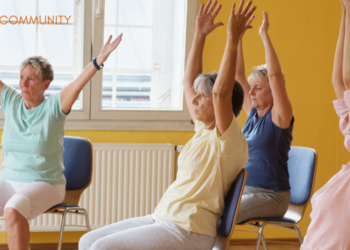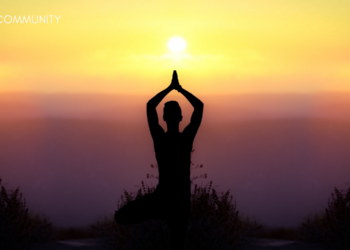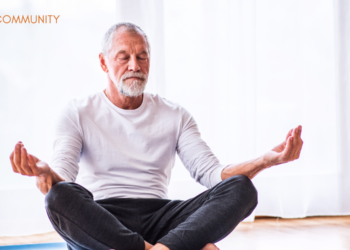As the years pass by, our bodies start experiencing symptoms of ageing. From aching backs to stiff joints, growing old comes with its own set of challenges. This is why it is important we incorporate some form of physical activity in our daily routine, especially as seniors.
Yoga is an excellent option because it is slow, low-impact, and does not require any special equipment. So, whether you’re 11, 21 or 61, you can never be too young or too old to reap the benefits of Yoga.
For seniors, Yoga offers several health benefits, including improved mobility, reduced anxiety, and strengthened bones. If you were to take a fall, Yoga could help you recover and bounce back faster.

Join Now >
The slow, measured movements that are associated with yoga aids balance and mobility. Moreover, there is no denying that Yoga is a mood booster; with the combination of movement, breathing, and meditation, Yoga is an extremely relaxing form of exercise. If you’re still not convinced about the benefits of Yoga, here’s how practising Yoga daily can help you.
Benefits of Yoga for seniors
- Improves balance and stability
Regular yoga practice helps strengthen your bones and muscles, which in turn improves your balance and stability. You may be shaky with a few poses at first, but over time your balance will gradually get better, and you will be able to hold the poses for longer.
- Reduces high blood pressure
With high blood pressure, the risk of stroke, heart and kidney diseases increases. Regular yoga practice helps reduce the effect of oxidative stress caused by free radicals. With regular yoga practice and a balanced diet, you can easily keep a check on your blood pressure.
- Reduces stress and anxiety
Yoga involves slow movements focusing on the breath, which helps relax your mind and body. Yoga sessions can be highly restorative, inducing a sense of calm and serenity. Studies suggest that Yoga has an overall positive impact on mood and mental health.
- Better sleep
Insomnia is a common concern among seniors, and Yoga can help address it. Studies show that seniors who practice yoga sleep better and longer. When you practice Yoga regularly, you feel more connected to your mind, body and the world around you; you are also less stressed and anxious, which helps you sleep better.
- Improves joint health
If you are someone that complains of achy, stiff joints and have limited mobility, then Yoga is the answer for you. Its slow, measured movements increase flexibility and promote the production of synovial fluid. Studies have also found that people suffering from osteoarthritis found Yoga to be beneficial for them.
- Give a sense of purpose
Attending a yoga class regularly establishes a sense of community helps develop social connections. Joining group classes also makes you accountable and gives you a sense of purpose.
Types of Yoga for seniors
Depending on your age and existing conditions, there are different styles of Yoga that you can choose from. Restorative Yoga is said to be highly beneficial for seniors as it is a slow and meditative form of Yoga that is designed to release tension passively, without stretching. Props are used to support the body, and poses are held for a long time.
If you’re relatively fit and want something more challenging, you can opt for Vinayasa yoga. This form of Yoga involves matching your breathing to a series of continuous movements. Meanwhile, if you are religious, you could choose to go with Kundalini yoga. This form of Yoga combines physical postures, breathing exercises, meditation, and chanting. If you’re someone who struggles with flexibility or is recovering from an injury, then Iyengar yoga is for you.
Once you have zeroed in on the kind of Yoga you want to practice, you can now explore the different poses. Here are a few different poses you can get started with
Yoga asanas for seniors
- Adho Mukha Svanasana or the Downward Facing Dog pose
This asana is excellent for joint health, flexibility and stretches your calves and lower back.
Start on your hands and knees and lift your hips up to the ceiling. Use your core strength and hold the pose for a few seconds or as long as you can. Lower yourself back and repeat 4-15 times. If you have wrist issues, you can modify the asana by putting your forearms flat on the mat.
- Bhujangasana or the Cobra pose
This asana is great for upper back strength, helps fight constipation, and mobilizes the spine.
Lie down on your stomach, place your forearms on that mat, and your elbows under the shoulder. With your palm firmly pressed downwards, use your back muscles to lift your upper body.
- Tadasana or the Mountain pose
This asana helps improve your posture and balance, relieves back pain and strengthens thighs and ankles.
Stand tall with your feet pressed firmly to the ground with your arms at your side. Actively engage your abdominal and leg muscles, and breathe four to five breaths.
- Vrksasana or the Tree pose
This asana helps boost leg and abdominal strength. It also helps improve balance and concentration.
Start with the Mountain pose, raise one leg so that it rests on your inner shin or thigh. Are you facing trouble balancing? Stand next to a wall or use a chair to support yourself.
- Balasana or the Child’s pose
This asana helps gently stretch your spine, thighs and hips. It relieves backaches, relieves tension, and aids digestion.
Sit on your heels with your knees together (or apart) and your bottom resting on your heel. Extend your arms in front of you with your palms facing down and your forehead touching the mat. Concentrate on your breath and hold the pose for a minute or as long as you can.
- Shavasana or the Corpse pose
This asana helps improve concentration and restores peace to the body and mind.
Lie down on your mat with your arms and legs lose, relaxed. Concentrate on your breath and inhale and exhale slowly.
Regular Yoga or any other form of physical exercise, healthy eating and routine medical care along with mental health checks can help seniors live their life to the fullest. If you’re worried about your health or mobility issues while practising Yoga, don’t worry, there is a modification for almost every asana. However, it is advisable to consult your healthcare provider before starting any new form of physical activity.











